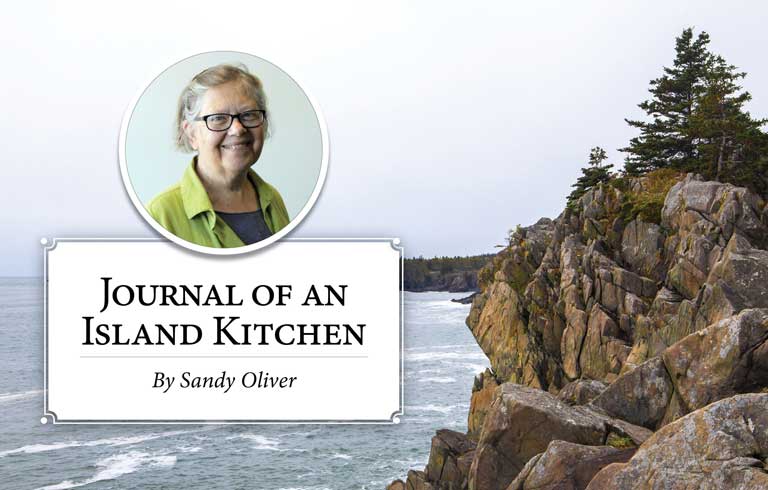Kitchens make a house a home. Kitchens create community. Our island has at least ten non-domestic kitchens in public gathering places. Stoves, sinks, fridges, counters, pots and pans, coffee makers, mugs, dishes, and flatware are enlivened with good smells and conversation.
We cluster up to exchange news and views, and end up being part of something greater than ourselves alone.
I’ve spent the most time cooking in the Second Baptist Fellowship Hall where a weekly lunch gave seniors (and sometimes youngers) a good hot meal, accompanied by music from our island-grown Charlie Pendleton Band. Fairly modern, with dishwasher and double sinks, a generous-sized island and cupboards full of ironstone dishes, it was dominated by an old beast of a gas range—six burners, a grill, and two ovens.
One grateful islander provided enough lobster for a feed which made a hugely favorable impression.
What a stove! Like driving a semi after spending hours in a VW bug. Problem was, the pilot lights burned so much gas the church people wisely turned them off, but then using the stove required quite a few moments lying on the floor with the steel apron removed so we could peer into the stove’s bowels to aim our lighted match at the pilot vent. At last, when we turned the oven on—vroom.
I loved that stove. It has been replaced by two more compliant, domestic-sized stoves, a wise and economical choice.
The Sewing Circle kitchen is identical to the one in an apartment I lived in 50 years ago. All one unit, probably dating to the 1950s, white enamel, containing a stove with three electric burners, oven, a narrow sink and drainboard, and half-fridge. At Circle, we never use the fridge so it’s storage space. Each member brings a mug for themselves and everything needed for coffee, tea, and eating the monthly birthday cake. An oil-cloth covered table with dish towels in its drawers holds delicious things that members bring to share. We use the microwave to heat soup or leftovers for lunch on our Cabin Fever Reliever Fridays in winter.
Even the historical society has a kitchen with fridge, stove, and sink. I recall potluck suppers, at least one chowder party, and a wedding reception emanated from that kitchen, though post-meetings refreshments in summer are more common.
The Community Center has three kitchens, one industrial-sized catering kitchen featuring a lot of stainless steel; a domestic-sized one in the Kids Zone; and another for a café which has seen several iterations over the past few years, and for which café staff gallop upstairs to the big kitchen for back-up prep space.
The seriously well-supplied Sporting Club kitchen makes possible all kinds of events: I’ve attended a wedding, a baby shower, and at least one St. Patrick’s day boiled dinner. In summer there’s a seafood festival with good smells of fried clams and sausage sandwiches full of onions and peppers. During the pandemic, the club produced hamburgers, French fries, and other welcome take-out food.
We used to vote in the Public Safety Building kitchen, the space where electric company repair crews from off-island have eaten dinners. In prolonged power outages, there’s food for them organized and cooked by volunteers. One grateful islander provided enough lobster for a feed which made a hugely favorable impression.
The most venerable is the Mason’s Hall kitchen, now the site of monthly bean suppers. The Masons formed in 1857 and the present hall, dedicated in 1907, contains a kitchen mostly occupied by a large furnace blowing warmth into the building’s farthest reaches. An old metal sink, and dark, varnished beaded board cupboards and counters line one wall and turn a right angle to a window overlooking the parking lot.
Just outside the kitchen, an L-shaped counter backed by a plain stove holds large trays for ham, crock pots for beans, pans full of mac and cheese, coleslaw, and green salad. A row of cupboards hold dishes for serving food, but without a way to wash them, the Masons use paper plates. Doesn’t matter; the beans taste just as wonderful as they would on china.
A well and a septic system will make the Mason’s kitchen fully functional but even without, their bean supper is just as delicious and convivial when three long tables fill with hungry islanders.
It’s good for neighbors to eat together. It’s harder to be a miserable human with your mouth full.
Sandy Oliver is a food historian who gardens, cooks, and writes on Islesboro. She may be reached at SandyOliver47@gmail.com.





